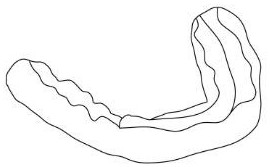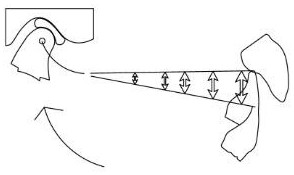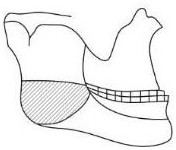Invisible correction method for treating class 2 and class 3 malocclusion by using occlusion repositioning device
An invisible correction and repositioning technology, applied in the field of malocclusion correction, can solve the problems of not being able to obtain rear support and occlusal, unable to change the occlusal curve, and limited height, so as to reduce the impact of muscle strength and occlusal force on the moved teeth Influence, save treatment costs, reduce the effect of usage
- Summary
- Abstract
- Description
- Claims
- Application Information
AI Technical Summary
Problems solved by technology
Method used
Image
Examples
Embodiment 1
[0048] Example 1: Invisible Correction Method for Type 2 Malocclusion
[0049] First prepare the occlusal repositioning device 1. The occlusal repositioning device 1 is a bilateral resin crown with the correct tooth shape. The length of the occlusal repositioning device 1 on both sides is the sum of the correct teeth of 3 or 4 posterior teeth. The height of the repositioning device 1 increases or decreases depending on the rear occlusal distance obtained after the mandible protrudes forward. The upper part of the occlusal repositioning device 1 is provided with a cusp structure 2, such as Figure 6 shown.
[0050] The occlusal repositioning device 1 on both sides is respectively fixed in the posterior teeth of the mandible, and then the upper and lower full-mouth models are taken, and the plaster model is cast and scanned. The obtained STL file is transferred to the invisible orthodontic design software for multi-step invisible orthodontic design , and finally form the STL de...
Embodiment 2
[0064] Example 2: Invisible correction of 3 types of malocclusion
[0065] First prepare the occlusal repositioning device 1. The occlusal repositioning device 1 is a bilateral resin crown with the correct tooth shape. The length of the occlusal repositioning device 1 on both sides is the sum of the correct teeth of 3 or 4 posterior teeth. The height of the repositioning device 1 is different depending on the vertical distance obtained in the posterior teeth after the mandible retreats to the upper and lower anterior teeth to open the locking knot. The lower part of the occlusal repositioning device 1 is provided with a cusp structure 2, such as Figure 13 shown.
[0066] The occlusal repositioning device 1 on both sides is respectively fixed on the bilateral maxillary posterior teeth, and then the full-mouth model of the upper and lower jaw is taken, and the plaster model is cast and scanned. The obtained STL file is transferred to the invisible orthodontic design software fo...
PUM
 Login to View More
Login to View More Abstract
Description
Claims
Application Information
 Login to View More
Login to View More - R&D
- Intellectual Property
- Life Sciences
- Materials
- Tech Scout
- Unparalleled Data Quality
- Higher Quality Content
- 60% Fewer Hallucinations
Browse by: Latest US Patents, China's latest patents, Technical Efficacy Thesaurus, Application Domain, Technology Topic, Popular Technical Reports.
© 2025 PatSnap. All rights reserved.Legal|Privacy policy|Modern Slavery Act Transparency Statement|Sitemap|About US| Contact US: help@patsnap.com



